Native Instruments Traktor Scratch Instruction Manual

TRAKTOR SCRATCH
Operation Manual

The information in this document is subject to change without notice and does not represent a commitment on the part of NATIVE INSTRUMENTS GmbH. The software described by this document is subject to a License Agreement and may not be copied to other media. No part of this publication may be copied, reproduced or otherwise transmitted or recorded, for any purpose, without prior written permission by NATIVE INSTRUMENTS GmbH, hereinafter referred to as NATIVE INSTRUMENTS. All product and company names are trademarks of their respective owners.
Furthermore, the fact that you are reading this text means you are the owner of legal version rather than an illegal, pirated copy. It is only through the loyalty and honesty of people like yourself that NATIVE INSTRUMENTS GmbH can continue to develop and create innovative audio software. On behalf of the entire company, thank you very much.
Authors and Revisions: Irmgard Bauer, Friedemann Becker, Jan Hennig, David Tinning - other valuable input from: Phil Lewis, Hobbes, Quartz, AudioRapture and all TRAKTOR Forum Users!
Special thanks to the Beta Test Team, who were invaluable not just in tracking down bugs, but in making this a better product.
© Native Instruments GmbH, 2007. All rights reserved.
Germany |
USA |
NATIVE INSTRUMENTS GmbH |
NATIVE INSTRUMENTS North America, Inc. |
Schlesische Str. 28 |
5631 Hollywood Boulevard |
D-10997 Berlin |
Los Angeles, CA 90028 |
Germany |
USA |
info@native-instruments.de |
sales@native-instruments.com |
www.native-instruments.de |
www.native-instruments.com |
Table Of Contents |
|
|
1. Audio 8 DJ and TRAKTOR Scratch Software Installation..................... |
7 |
|
1.1 Installing the AUDIO 8 DJ drivers under Mac OS X......................... |
7 |
|
1.2 |
Installing TRAKTOR Scratch under Mac OS X................................ |
8 |
1.3 |
Installing the AUDIO 8 DJ under Windows..................................... |
9 |
1.4 Installing TRAKTOR Scratch under Windows................................ |
10 |
|
2. Hardware Setup............................................................................. |
11 |
|
2.1 Multicore Cables....................................................................... |
11 |
|
2.2 |
Detailed Instructions for Hooking up your |
|
|
Turntables with the Multicore Cables........................................... |
13 |
2.3 |
Detailed Instructions for Hooking up your |
|
|
CD-Players with the Multicore Cables.......................................... |
14 |
3. First Steps with TRAKTOR Scratch.................................................. |
15 |
|
3.1 Starting the Software................................................................. |
15 |
|
3.2 |
Registration and Product Authorization........................................ |
15 |
3.3 |
Verifying the Connection to the AUDIO 8 DJ................................. |
16 |
3.4 |
Testing the Outputs of the AUDIO 8 DJ with a Demo Track ........... |
16 |
3.5 |
Testing the Inputs of the AUDIO 8 DJ with |
|
|
Control Vinyl or Control CD........................................................ |
17 |
3.6 |
Playing a Track with Vinyl or CD Control....................................... |
18 |
3.7 Internal, Relative and Absolute Playback Tracking Modes............... |
19 |
|
3.8 |
The Control Zones on Vinyl........................................................ |
20 |
3.9 The Control Zones on CD........................................................... |
21 |
|
3.10 Test Driving on Your own Music................................................. |
21 |
|
4. Understanding the Scratch Panel................................................... |
23 |
|
4.1 The Calibration Process............................................................ |
23 |
|
4.2 |
Sticker View............................................................................. |
25 |
5. More about the AUDIO 8 DJ ......................................................... |
26 |
|
5.1 Back View and Connections....................................................... |
26 |
|
5.2 |
Front View and Connections....................................................... |
27 |
5.3 |
Advanced Setups..................................................................... |
28 |
5.4 |
Status LEDs............................................................................. |
31 |
5.5 |
Control Panel.......................................................................... |
32 |
5.6 |
Audio Statistics....................................................................... |
33 |
5.7. Technical Specification............................................................ |
33 |
|
6. Beatport™ - Online Dance Music Store™....................................... |
35 |
|
7. The User Interface of TRAKTOR Scratch.......................................... |
37 |
|
7.1 Terminology.............................................................................. |
37 |
|
7.2 Knob and Fader Control............................................................. |
41 |
|
7.3 Adjusting the Look of Traktor..................................................... |
43 |
|
|
TRAKTOR SCRATCH – |
|
8. Using the Track Browser................................................................ |
50 |
|
8.1 Preparing the Set..................................................................... |
50 |
|
8.2 Searching for tracks................................................................. |
54 |
|
8.3 Editing tracks.......................................................................... |
59 |
|
8.4 Working with the Collection and Playlists.................................... |
64 |
|
9. Backup and Transfer of your Collection............................................ |
70 |
|
9.1 TRAKTOR File Formats and TRAKTOR Folder............................... |
70 |
|
9.2 Complete Backup...................................................................... |
70 |
|
9.3 Automatic Backup (Security Backup)........................................... |
71 |
|
10. Controlling the Decks................................................................... |
72 |
|
10.1 General Deck Behavior............................................................. |
72 |
|
10.2 |
Regular Cue Points ................................................................ |
77 |
10.3 |
Special Cue Points.................................................................. |
78 |
10.4 |
Defining and Using Beatgrids................................................... |
79 |
10.5 |
Details Pages and Panels ....................................................... |
84 |
11. Advanced Playback Functions ...................................................... |
87 |
|
11.1 Beatjump ............................................................................. |
87 |
|
11.2 Duplicate Deck...................................................................... |
88 |
|
11.3 Loops .................................................................................. |
89 |
|
12. Effects...................................................................................... |
90 |
|
12.1 Effects Routing...................................................................... |
90 |
|
12.2 |
Available Insert Effects ........................................................... |
91 |
12.3 |
Available Send Effects ........................................................... |
93 |
13. Recording.................................................................................. |
98 |
|
13.1 Understanding Audio Recording............................................... |
98 |
|
14. MIDI and Hotkeys...................................................................... |
101 |
|
14.1 Controlling TRAKTOR with MIDI and Hotkeys........................... |
101 |
|
14.2 |
Keyboard Hotkeys................................................................. |
101 |
14.3 |
Midi Hotkeys........................................................................ |
102 |
14.4 |
Managing your MIDI and Hotkey Files...................................... |
103 |
15. Preferences............................................................................... |
109 |
|
15.1 Audio Setup.......................................................................... |
109 |
|
15.2 |
Deck Preferences.................................................................. |
110 |
15.3 |
Browser Preferences.............................................................. |
112 |
15.4 |
Recording............................................................................. |
113 |
15.5 |
Hotkey and MIDI Setup.......................................................... |
114 |
15.6 |
Appearance.......................................................................... |
115 |
16. Tips & Tricks............................................................................. |
116 |
|
16.1 Playing in Reverse................................................................. |
116 |
|
16.2 |
Organizing Playlists............................................................... |
116 |
16.3 |
Using the Beatmasher in Musical Values.................................. |
117 |
– TRAKTOR SCRATCH |
|
|
16.4 Stickering the Control Record................................................. |
118 |
|
16.5 Airplane Mode...................................................................... |
120 |
|
17. Troubleshooting......................................................................... |
121 |
|
17.1 What is Latency?................................................................... |
121 |
|
17.2 |
Hardware Troubleshooting....................................................... |
122 |
17.3 |
How to check if the driver is installed correctly?........................ |
123 |
17.4 |
How to avoid Ground Loops.................................................... |
125 |
17.5 |
How to use the AUDIO 8 DJ with a Laptop............................... |
125 |
17.6 |
TRAKTOR Scratch won’t start (or crashes upon start):............... |
127 |
17.7 Tracks load but won’t play!..................................................... |
127 |
|
17.8 |
Decks Play, Master Level Flashes, but no Sound!...................... |
129 |
17.9 Audio Pops, Clicks and/ or Distortions!..................................... |
130 |
|
17.10 The Waveforms (or other Graphics) Pause or Stutter! ............... |
131 |
|
17.11 I get no Response from my MIDI-Controller............................. |
131 |
|
18. Optimizing your Computer.......................................................... |
133 |
|
18.1 Macintosh Optimization.......................................................... |
133 |
|
18.2 Windows Optimization........................................................... |
134 |
|
19. Getting Help.............................................................................. |
136 |
|
19.1 Knowledge Base/ Readme/ Online Support............................... |
136 |
|
19.2 Forum.................................................................................. |
136 |
|
19.3 Updates............................................................................... |
137 |
|
20. Hotkeys.................................................................................... |
137 |
|
21. Index........................................................................................ |
139 |
|
TRAKTOR SCRATCH –
Dear Customer,
Thank you for purchasing TRAKTOR Scratch, and for trusting in the quality of NATIVE INSTRUMENTS products.
TRAKTOR Scratch is an integrated software and hardware system for DJ's made of several components:
•AUDIO 8 DJ, your new professional 8 In 8 Out USB 2.0 audio interface
•Control Vinyls and CD's
•The Multicore Audio Cable, for connecting your turntables, AUDIO 8 DJ and mixer
•TRAKTOR Scratch, the software connecting these components to your digital music archive
Years of experience in the domain of vinyl control for digital music and the fast AUDIO 8 DJ interface have allowed us create an astonishingly tight system, that really feels like a Native Instrument.
Our thanks go to the fathers of the idea of digital vinyl control, and to the minds that have brought the system to this level of quality.
Enjoy it!
NATIVE INSTRUMENTS
– TRAKTOR SCRATCH
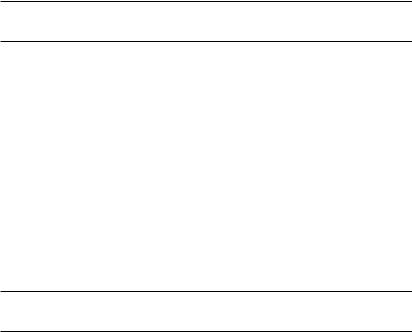
1. Audio 8 DJ and TRAKTOR Scratch Software
Installation
TRAKTOR Scratch is an integrated Hardware and Software System. Please proceed as follows for installing the components of this system.
The correct order of installation is:
•Installing the AUDIO 8 DJ drivers (software)
•Connecting the AUDIO 8 DJ hardware
•Installing the TRAKTOR Scratch software
•Authorizing TRAKTOR Scratch
Do not connect the audio interface before the installer prompts you as the operating system may install the wrong drivers.
1.1 Installing the AUDIO 8 DJ drivers under Mac OS X
Installation of the AUDIO 8 DJ
Place the installation CD in the CD-ROM drive of your computer. Double-click on the TRAKTOR CD icon to open the contents of the CD. Double-click the AUDIO 8 DJ Driver installer.
First, the installer shows a start image. When you click Continue, a dialog will open in which you can choose the mode of installation as well as the destination folder.
The default installation path is the Applications/Audio 8 DJ Driver folder. Please follow the onscreen installation instructions provided.
Note: You cannot install the AUDIO 8 DJ on a USB 1.1 port – a USB 2.0 port is required.
TRAKTOR SCRATCH –

Uninstalling the AUDIO 8 DJ
To uninstall the AUDIO 8 DJ drivers from your computer, proceed as follows:
•Delete the folder Applications/Audio 8 DJ Driver.
•Delete the file TraktorScratch.plist in Root/ Library/ Preferences.
•Delete the file TraktorScratch.plist in User/ Library/ Preferences. Afterwards, empty the trash bin to completely erase the program.
Note: Please always refer to the Readme file on the installation CD as it contains last minute information that may not be available in the printed manual.
1.2 Installing TRAKTOR Scratch under Mac OS X
System requirements
To use the TRAKTOR Scratch software on a Macintosh Computer, your system must meet the following requirements:
•G4 1.4 GHz, Mac OS 10.4.8 or Intel® Core™ Duo Family, 512 MB RAM
•USB 2.0 Interface
Installation of TRAKTOR Scratch
Place the installation CD in the CD-ROM drive of your computer. Double-click on the TRAKTOR CD icon to open the contents of the CD. Double-click the TRAKTOR installer.
First, the installer shows a start image. When you click Continue, a dialog will open in which you can choose the mode of installation as well as the destination folder.
The default installation path is the Applications/Traktor Scratch folder. Please follow the onscreen installation instructions provided.
– TRAKTOR SCRATCH
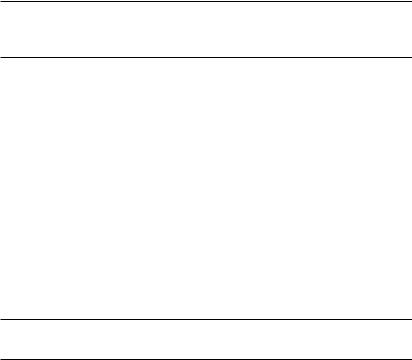
Uninstalling TRAKTOR Scratch
To uninstall TRAKTOR Scratch from your computer, proceed as follows:
•Delete the folder Applications/Traktor Scratch.
•Delete the file TraktorScratch.plist in Root/ Library/ Preferences.
•Delete the file TraktorScratch.plist in User/ Library/ Preferences. Afterwards, empty the trash bin to completely erase the program.
Note: Please always refer to the Readme file on the installation CD as it contains last minute information that may not be available in the printed manual.
1.3 Installing the AUDIO 8 DJ under Windows
Installation of the AUDIO 8 DJ
•Place the installation CD in the CD-ROM drive of your computer.
•Use the Windows Explorer to browse the contents of the CD.
•Start the installation by double-clicking on Audio 8 DJ Driver Setup. exe.
•Follow the onscreen instructions.
The setup program will lead you through the installation process. As the path for installation the setup will suggest C:\Program Files\NATIVE INSTRUMENTS\ Audio 8 DJ Driver. You can also choose another destination folder if you wish.
Note: You cannot install the AUDIO 8 DJ on a USB 1.1 port – a USB 2.0 port is required.
Uninstalling the AUDIO 8 DJ
To uninstall the AUDIO 8 DJ drivers from your computer, use the following steps:
•Open C:\Program Files\NATIVE INSTRUMENTS\Audio 8 DJ Driver.
•Double-click the Unwise tool to begin un-installation.
•Choose Automatic from the following dialog.
TRAKTOR SCRATCH –

Note: Please always refer to the Readme file on the installation CD as it contains last minute information not available in the printed manual.
1.4 Installing TRAKTOR Scratch under Windows
System requirements
To use the TRAKTOR Scratch software on a PC computer, your system must meet the following minimum requirements:
•Pentium/ Athlon 1.4 GHz, Windows XP Service Pack 2, 512 MB RAM
•USB 2.0 Interface
Installation of TRAKTOR Scratch
•Place the installation CD in the CD-ROM drive of your computer.
•Use the Windows Explorer to browse the contents of the CD.
•Start the installation by double-clicking on Setup.exe.
•Follow the onscreen instructions.
The setup program will lead you through the installation process.
Uninstalling TRAKTOR Scratch
To uninstall TRAKTOR Scratch from your computer, use the following steps:
•Open C:\Program Files\NATIVE INSTRUMENTS\Traktor Scratch.
•Double-click the Unwise tool to begin un-installation.
•Choose Automatic from the following dialog.
Note: Please always refer to the Readme file on the installation CD as it contains last minute information not available in the printed manual.
10 – TRAKTOR SCRATCH
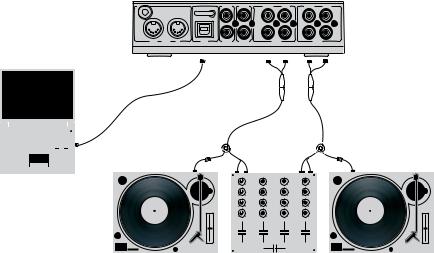
2. Hardware Setup
2.1 Multicore Cables
TRAKTOR Scratch goes one step beyond all current digital vinyl systems in offering an innovative way of connecting your audio interface to the turntables. The Multicore cables provided in the package unify the following functions into one unique solution:
•Connecting the turntables to the inputs of the AUDIO 8 DJ
•Connecting the outputs of the AUDIO 8 DJ to the mixer
•Connecting the turntables to the mixer, for playing regular vinyl
•The color coding of the multi-pin XLR connectors make cabling errors impossible and allows connection with 2 clicks when switching DJ’s
•Long cables allow the AUDIO 8 DJ to be placed on either side of the turntables
|
|
|
|
OUT 7|8 |
OUT 5|6 |
OUT 3|4 |
IN 3|4 |
OUT 1|2 |
IN 1|2 |
GROUND |
|
|
|
|
|
|
|
|
|
OUT |
MIDI |
IN |
USB |
CH. D |
CH. C |
|
CH. B |
|
CH. A |
Standard connection with turntables
TRAKTOR SCRATCH – 11

The male part of each Multicore cable (XLR-connector with pins) has 4 colored RCA connectors. Each of the cables is for one deck and provides the Control Signal to the audio interface via the black and red connector, whilst picking up audio from the TRAKTOR Scratch decks via the white and yellow connector.
The female part of each Multicore cable has six RCA connectors: 2 female and 4 male. Each of the cables is for one Deck and picks up the Control Signal from the turntable or CD player via the red and white female connectors labeled Player (TT/CD). It then splits it into one signal to the AUDIO 8 DJ via the XLR connector, and one signal to the mixer via the male RCA connectors labeled Mixer TT/CD. At the same time it provides audio from the TRAKTOR Scratch line input of the mixer via the second pair of male RCA connectors labeled Mixer Line In.
The cable is suited for pre-installation as it leaves the turntables connected to the mixer and therefore fully operational for DJ’s playing regular vinyl or CDs. To insert the cable into an existing setup, unplug the turntables from
12 – TRAKTOR SCRATCH
the mixer one by one, connect them with the female RCA connectors and plug the RCA connectors labeled Mixer TT/CD into the previous inputs of the turntables that you just unplugged. Check if the turntable can still be heard on the same channel of the mixer after installation of the cable.
2.2 Detailed Instructions for Hooking up your Turntables with the Multicore Cables
Connecting the Multicore Cables with the AUDIO 8 DJ
•Take the male part of the first Multicore cable with the four RCAs that are all having different colors.
•Connect the four RCAs with the respective colored plugs of the Ch. A section of your AUDIO 8 DJ. This corresponds to connecting the RCA pair labeled AUDIO 8 DJ Output with the Out 1/2 of your AUDIO 8 DJ, and the RCA pair labeled Audio DJ Input with the Input 1/2 of the AUDIO 8 DJ.
•Take the male side of the second Multicore cable (with the four RCAs all having a different color).
•Connect the four RCAs with the respective colored plugs of the Ch. B section of your AUDIO 8 DJ. This corresponds to connecting the RCA pair labeled AUDIO 8 DJ Output with the Out 3/4 of your AUDIO 8 DJ, and the RCA pair labeled Audio DJ Input with the Input 3/4 of the AUDIO 8 DJ.
Connecting the Multicore Cables with Your Turntables and Your Mixer
•Take the female part of the first Multicore cable with six RCA cables
-four male and two female plugs.
•Plug the left turntable (Deck A) into the two female RCAs, labeled with
Player TT/CD.
•Plug the two RCAs labeled Mixer TT/CD into the Phono Inputs of Deck A (left turntable) of your hardware mixer.
•Plug the two RCAs labeled Mixer Line/In into the Line Inputs of Deck A (left turntable) of your hardware mixer.
•Take the female part of the second Multicore cable with six RCA cables
-four male and two female plugs.
•Plug the right turntable (Deck B) into the two female RCAs, labeled with Player TT/CD.
TRAKTOR SCRATCH – 13

•Plug the two RCAs labeled Mixer TT/CD into the Phono Inputs of Deck B (right turntable) of your hardware mixer.
•Plug the two RCAs labeled Mixer Line/In into the Line Inputs of Deck B (right turntable) of your hardware mixer.
2.3Detailed Instructions for Hooking up your CD-Players with the Multicore Cables
Connecting the Multicore Cables with the AUDIO 8 DJ
•Connect the Multicore cable with the AUDIO 8 DJ as described above for turntables but switch the Input Mode on the AUDIO 8 DJ to Timecode CD/ Line (see chapter 5; More about the AUDIO 8 DJ).
Connecting the Multicore Cables with Your CD-Players and Your Mixer
•Take the female part of the first Multicore cable with six RCA cables
-four male and two female plugs.
•Plug the left CD-Player (Deck A) into the two female RCAs, labeled with
Player TT/CD.
•Plug the two RCAs labeled Mixer Line/In into the Line Inputs of Deck A (left CD-Player) of your hardware mixer.
•Plug the two RCAs labeled Mixer TT/CD into another Line Input of Deck A (left CD-Player) of your hardware mixer.
•Take the female side of the second MultiCore cable with six RCA cables,
-four male and two female plugs.
•Plug the right CD-Player (Deck B) into the two female RCAs, labeled with Player TT/CD.
•Plug the two RCAs labeled Mixer Line/In into the Line Inputs of Deck B (right CD-Player) of your hardware mixer.
•Plug the two RCAs labeled Mixer TT/CD into another Line Input of Deck B (right CD-Player) of your hardware mixer.
Note: Some mixers don’t have two Line Inputs per channel. To use the Control Signal control, it is only necessary to have the RCAs called Mixer Line/In connected. The other pair (Mixer TT/CD) can be plugged in another Line Input, since this connection is only needed for playing regular CDs or can be left out completely.
14 – TRAKTOR SCRATCH
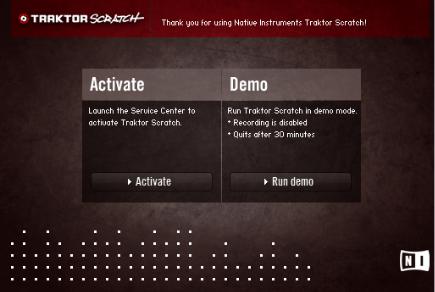
3. First Steps with TRAKTOR Scratch
3.1Starting the Software
•Mac OS X: Go to Macintosh HD > Applications > Traktor Scratch and double-click on the TRAKTOR Scratch program icon.
•Windows: Go to Start > Programs > NATIVE INSTRUMENTS Traktor Scratch and click the TRAKTOR Scratch program icon.
3.2Registration and Product Authorization
When starting TRAKTOR Scratch for the first time, you will see the following screen:
•Choose Activate to start the NI Service Center for authorizing the software. This will start the Service Center, which gives you a comfortable step-by-step walk through the authorization process. You find more information about the Service Center in a separate Setup Guide booklet included in your TRAKTOR Scratch package. Service Center also includes an Update Manager that helps you download the most recent version of TRAKTOR. You should check regularly for updates to TRAKTOR for best performance and compatibility with other audio applications.
TRAKTOR SCRATCH – 15

•Choose Run Demo to run TRAKTOR Scratch in Demo Mode. Once you have decided to purchase a product, all you need do is unlock the demo version by entering a valid serial number – it then instantly becomes the full version. Demo Mode has the following restrictions: audio processing stops after 30 minutes, audio recording disabled, no saving of hotkey and midi assignments.
Note: you have to restart TRAKTOR Scratch to change from Demo Mode into Full Mode.
3.3 Verifying the Connection to the AUDIO 8 DJ
Verify if the AUDIO monitor LED in the header of TRAKTOR Scratch is green. This color indicates the correct connection with the audio interface. If the LED is red or grey you have to verify the connection to the AUDIO 8 DJ. You may have to restart TRAKTOR Scratch to get the connection to work. In case of problems, please refer to chapter 17 (Troubleshooting).
3.4Testing the Outputs of the AUDIO 8 DJ with a Demo Track
•Open the Demo Playlist by double-clicking the Playlist/ Mixes folder in the Tree Window and then opening the Demo Playlist.
•Right-/ Ctrl-click on one of the tracks in the List and choose Load Track in Deck A. This will load the track in Deck A, and the track Waveform will be displayed.
•Click the Play button underneath Deck A.
•The Waveform of the track will start to move from right to left and the
Master Level Meter in the header will start to flash with the music.
•If the Waveform does not scroll from left to right, you’re having a soundcard problem. Read more in chapter 17 ( Troubleshooting).
•On the AUDIO 8 DJ hardware the LEDs labeled OUT 1|2 will start flashing green.
•If you hear no sound, but all indicators are functional and lit, you may have accidentally moved a knob or fader on your hardware mixer, or something may be wrong with your cable connections. Please verify your setup as described in chapter 17 (Troubleshooting).
16 – TRAKTOR SCRATCH

3.5 Testing the Inputs of the AUDIO 8 DJ with Control Vinyl or Control CD
Now that the outputs of the AUDIO 8 DJ are working properly, we have to check the inputs required for turntable control of TRAKTOR Scratch. Proceed as follows:
•Put the Control Records on your turntable (or the Control CDs in your CD-Player) and play it back.
•If you are playing Control Records on turntables, set the AUDIO 8 DJ Input Mode for channels A and B to Timecode Vinyl by toggling through the modes with the INPUT MODE button on the front panel.
•If you are playing Control CDs, set the AUDIO 8 DJ Input Mode for channels A and B to Timecode CD by toggling through the modes with the INPUT MODE button on the front panel.
•Check the Input LEDs on channels A and B labeled IN 1|2 and IN 3|4.
They should flicker green.
•If the LEDs are flickering red, the inputs are clipping. This happens when the wrong Input Mode is selected (connecting CD players in Vinyl Mode).
•If the LEDs don’t flicker at all, the signal is too weak or missing. This can either be due to the wrong Input Mode (connecting turntables in CD Mode) or to loose or broken cables.
TRAKTOR SCRATCH – 17
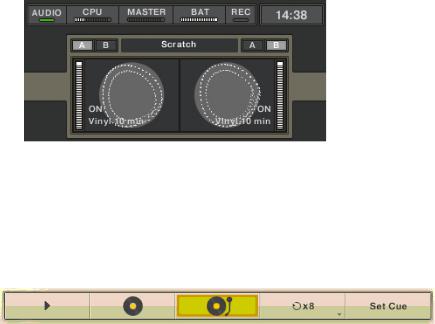
•Next, check if the control signal of both players are showing up in the scopes. The message in the scope should say ON and the scope figures should look like this:
•If the figures do not show up or look different, or the displayed message does not say ON, please refer to section 4.1 (The Calibration Process).
•Finally make sure that the Deck Assignment buttons labeled A and B above each scope are lit like in the above picture: the left input is assigned to Deck A and the right input to Deck B.
•The Absolute Tracking button underneath the waveform is highlighted in yellow indicating that the deck is ready to go:
3.6Playing a Track with Vinyl or CD Control
Using Control Vinyl:
•Load a track in Deck A as described before.
•Place the needle at the beginning of the record and start your turntable.
•The track in the deck will start to play and you will hear it over the speakers.
•Put your hand on the record and move the record back and forth. Notice your manual control over the speed.
•Pick up the needle and drop it somewhere else on the records to cue within the track.
•Load a second track in Deck B and start mixing as you would using regular turntables.
18 – TRAKTOR SCRATCH

•Move the Pitch Fader of the second turntable to match the beats.
•Use the channeland crossfader on your mixer as normal.
Using Control CD:
•Load a track in Deck A as described in the section before.
•Start your CD-Player – it will shortly play track #1 (called Lead In) and then start to play track #2. This track is used for regular playback.
•The track in the deck will start to play and you will hear it over the speakers.
•Put your hand on the jog wheel and move the platter back and forth. Notice your manual control over the speed.
•Seek through the track using the Track Search button on the CD player.
•Load a second track in Deck B and start mixing as you would using regular DJ CD players.
•Move the Pitch Fader of the second CD player to match the beats.
•Use the channeland crossfader of your mixer as normal.
3.7Internal, Relative and Absolute Playback Tracking Modes
From left to right: Internal, Relative and Absolute Mode buttons, then Loop and Set Cue buttons.
We have already encountered Internal Playback mode when testing the soundcards outputs. Internal Playback means that you control playback via the Play button and the software pitch fader, regardless of your external turntables or CD players
Absolute Playback Tracking mode is activated by pressing the button with the representation of a record and a tonearm. This absolutely links the position of the tonearm on the record to the playback position of your track. Each action on the tonearm has direct effect on playback of the track in TRAKTOR Scratch, be it moving of the record back and forth or placing the needle on another part of the record (Needle Drop)
While in Absolute Tracking Mode, press the Loop button on the right of the Absolute Tracking button. You will notice the following:
• Playback of the track starts looping the current part of the song
TRAKTOR SCRATCH – 19

•Playback mode has switched to the button showing only a record. This mode is called Relative Tracking Mode.
Touch the record or jog wheel to see that you still have control over the track, but when you lift the needle and place it somewhere else on the records, you will notice that the software still plays the loop.
This happens because when setting a Loop the software stops to lock to the position of the needle. While the software starts to repeat the same part of the song, the needle on the record moves forward creating a growing offset to the software. The software therefore ignores the position of the needle and only tracks the rotational speed of the record.
The position of the needle is ignored except in one special area of the records: the Lead In. Dropping the needle into the Lead In will skip back to the beginning of the song, also when in Relative Tracking Mode.
3.8 The Control Zones on Vinyl
The Control Vinyl consists of the following three zones, each with different playback functions :
Lead In – The first few Rounds of the Record
Dropping the needle into the Lead In Zone of the record will skip to the beginning of the track. Use this to skip back to the beginning of a track when playing in the Relative Tracking Mode.
Note: Find options to customize the automatic absolute mode in
Preferences > Deck Preferences > Loading and Preferences > Deck Preferences > Transport.
Playback Zone - Main Part of the Record
This is subdivided into 10 tracks on side A and 15 tracks on side B. This zone is used for regular playback. The divisions are visual markers of time, which do not affect the continuous playback of the loaded track.
Scroll Zone – Last two Tracks of the Record.
Dropping the needle in the Scroll Zone allows you to scroll up and down through your playlist by manually spinning the record forward or backward. To play the selected track, simply place the tonearm back into the Playback Zone.
20 – TRAKTOR SCRATCH

Note: If your track exceeds the 10 minutes Playback Zone it will continue playing normally in the Scroll Zone – you have to lift and drop the needle again to stop the playback and switch to Scroll Mode. Even if you reach the end of the record, the track will continue to play as there is an endless groove at the end of the record!
3.9 The Control Zones on CD
The control CD consists of the following three tracks, each with different playback functions:
CD Track #1: Lead In – (0:04 min)
Skipping to CD Track #1 will skip into the Lead In of the loaded track. Use to skip back to the beginning of a track when playing in Relative Tracking Mode.
CD Track #2: Playback Zone – (27:30)
This track is used for regular playback.
CD Track #3: Scroll Zone – (2:30)
Skipping to CD track #3 allows you to scroll up and down through your playlist by manually spinning the jog wheel of your CD player. To play the selected track, simply skip back to CD track # 1.
Note: If your track exceeds the 27:30 minutes Playback Zone it will continue playing back normally in the Scroll Zone – you have to skip manually to track #3 again to switch to Scroll Mode. And even if your track exceeds the whole 30 minutes, it will continue playing in Internal Mode!
3.10 Test Driving on Your own Music
As you probably already have a collection of music files on your hard drive, you might want to test drive TRAKTOR Scratch with your own music.
•Open a window of the Mac Finder or Windows Explorer containing the tracks that you want to play.
•Click and hold one of your tracks and drag it from the external window to the TRAKTOR Scratch window and into Deck A.
TRAKTOR SCRATCH – 21
•After a short loading time you should see the Waveform of your track building up in the display.
•Click and hold one of your tracks and drag it from the external window to the TRAKTOR Scratch window and into Deck B.
•Play and mix the tracks as you have learned in the previous section.
22 – TRAKTOR SCRATCH
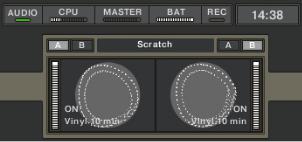
4. Understanding the Scratch Panel
4.1 The Calibration Process
The Calibration is triggered when you assign an input to a deck in TRAKTOR Scratch by pressing one of the Deck Assign buttons labeled A or B above the scopes.
Calibration is required for the following reasons:
•Detection of the type of media (vinyl or CD), as well as the side of the played vinyl
•Detection of the input level of the control signal
•Detection of the connection and the quality of the signal and if it is sufficient for tracking
•Correction of reversed channels
When you start the calibration by pressing one of the buttons labeled A or B (while letting the record/ CD play), the decoder evaluates the signal that is shown by the Position Meters on each side of the scopes. The Position Meters indicate how many valid position readouts have been transmitted by the turntable or CD player.
If the meters do not turn white, something is wrong with your control signal.
The decoder outputs a series of messages, qualifying the result of the calibration process:
ON
If the calibration was successful, you will find the message ON along with your currently used medium (Vinyl 10, Vinyl 15 or CD) in the Control Signal graphic as shown below:
Example of a good Control Signal
TRAKTOR SCRATCH – 23
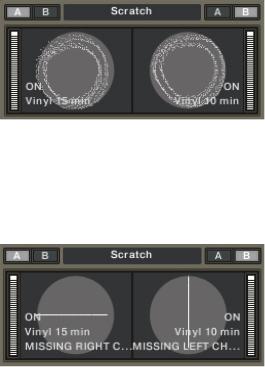
Browsing
You dropped the needle in the Scroll Zone (see chapter 3.8 (The Control
Zones on Vinyl) and 3.9 (The Control Zones on CD). You should see in the List Window how you scroll through your playlist backwards and forwards according to the movement of the record/ CD.
Whenever you stop the movement, the respective track will be loaded into the deck you’re scrolling in.
Calibration Failed
No valid positions detected, or in other words: the calibration was not successful. TRAKTOR Scratch will nevertheless work in Relative Tracking Mode.
A reason for a failed calibration can be deterioration of pick-ups and records. The status of records and needles can be judged by observing the Scope figures. The more the circles are distorted and fuzzy the higher the degradation of the records and pick-ups.
Example of a bad Control Signal.
MISSING RIGHT CHANNEL or MISSING LEFT CHANNEL
The left or right channel is10% quieter than the other channel. A backward movement of the Control Vinyl/ CD cannot be computed, but tempo variations and needle dropping should still be possible. A missing channel can be seen easily seen on the Control Signal panel:
Example of missing channels.
24 – TRAKTOR SCRATCH

CHANNEL SWAP
The decoder exchanges the stereo channels internally. There are three possible causes:
•Incorrect wiringthe stereo channels are swapped.
•One of the channels has a phase invertion. If you’re sure that the channels have not been swapped you should check the needle, as the detection of the absolute position is slower and less reliable.
•The Control Vinyl/ CD was spinning backwards during the calibration. The calibration failed and you should see the message Calibration Failed
Skipping
This shows up when the needle skips on the record.
4.2 Sticker View
Besides showing the incoming signal in the Scope View, the Scratch Panel can be switched to showing the motion of the records as rotating labels. Toggle between the Scope and the Sticker View by clicking on the Scratch panel:
Sticker View
Find out more about placing stickers on your records that reflect the white dots in the Sticker View in chapter 16.4 (Stickering the Control Record).
TRAKTOR SCRATCH – 25
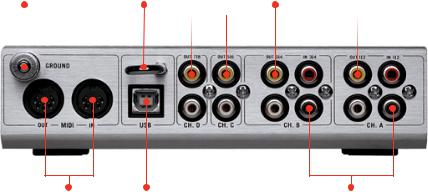
5. More about the AUDIO 8 DJ
The AUDIO 8 DJ combines high end audio quality with unmatched connectivity and a rock-solid mobile design. It is destined to be the beating heart of your DJ set-up and provides a professional level interface between your preferred software and your audience:
•Cirrus-Logic™ AD-DA converters guarantee a sound quality that will impress even the most discerning audiophiles.
•Low latency drivers along with hi-gain output levels on all channels prove the AUDIO 8 DJ's professional credentials.
•8 inputs, 8 outputs, MIDI I/O, 1/4" headphone connector, and 20 status LEDs for full visual control.
5.1Back View and Connections
Ground Screw |
USB Security Hook |
8 Outputs / 4 Stereo Channels |
|
|
|
|
|
|
|
|
|
|
|
|
|
MIDI |
USB 2.0 |
4 Inputs/2 Stereo |
Input/Output |
Bus-Powered |
[4 more on front] |
•IN 1/2 – OUT 1/2 (CH A): Connect here the male XLR part of the Multicore cable to control Deck A.
•IN 3/4 – OUT 3/4 (CH B): Connect here the female XLR part of the Multicore cable to control Deck B.
•OUT 5/6 (CH C): Connect to auxiliary input of your mixer when using send effects.
•OUT 7/8 (CH D): Connect to auxiliary input of your mixer when using send effects.
26 – TRAKTOR SCRATCH

•USB: Connect here your computer via USB 2.0.
•USB Security Hook: Wrap your USB cable around this to prevent accidental disconnection.
•MIDI IN/ OUT: Connect your MIDI device here.
•GROUND: If connecting the turntable grounds to the mixer gives unsatisfactory results, ground your turntables here.
5.2Front View and Connections
MIC |
|
|
|
|
|||
Level Control |
Input 7/8 |
HP Level |
|||||
|
|
MIC/Channel |
|
|
|
|
|
|
|
|
|
|
|
||
|
|
Selector |
|
|
|
|
|
|
|
|
|
|
|
|
|
|
|
|
|
|
|
|
|
|
|
|
|
|
|
|
|
|
|
|
|
|
|
|
|
|
|
|
|
|
|
|
|
|
|
|
|
|
|
|
|
Monitor
In 5/6 or Out 7/8
XLR MIC or |
Input Mode |
Headphone |
Input 5/6 |
Selector |
Output |
•MIC: Connect a microphone via XLR here.
•IN 5/6 (CH C): Connect to effects output of your mixer for using send effects.
•MIC GAIN: Control the microphone volume here.
•MIC/ LINE Selector: Select your input source.
•IN 7/8 (CH D): Connect to second output of your mixer, e.g. for recording purposes.
•INPUT MODE: Toggle between the input modes of Deck A and B (Control Vinyl, Control CD/ Line, Phono)
•HEADPHONES: Connect your headphones here if you don’t want to connect them at the mixer.
•SOURCE: Toggle between IN 5/6 and OUT 7/8 as sources.
•VOLUME: Controls the headphones volume.
TRAKTOR SCRATCH – 27
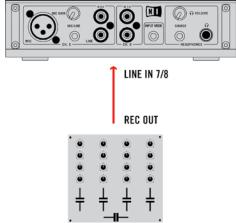
5.3 Advanced Setups
The architecture of the AUDIO 8 DJ is very versatile and can be used in very advanced setups. Here is a selection of the most common setups that go beyond the basic setup dicussed so far.
Recording Setup
The built-in recorder of TRAKTOR Scratch allows you to record your performance. This setup requires a second output on the mixer, often labeled REC or OUT 2. Connect this output to Inputs 7|8 (= Channel D) of the AUDIO 8 DJ.
In the software, set the recording input to Channel D, as described in chapter 15.4 (Recording).
Recording Setup
28 – TRAKTOR SCRATCH

Using a Microphone
If you want to record a microphone within TRAKTOR Scratch, you need to route the sound of the microphone through the audio interface before feeding it into the mixer. The following scheme describes how to achieve this:
•Connect the microphone to the Mic In on the AUDIO 8 DJ
•Switch the Input Selector of Channel C to MIC
•Adjust the microphone input level
•Switch the Headphone Source to IN 5|6
•Connect the Headphone Output of the AUDIO 8 DJ with an available auxiliary input of your mixer.
Microphone Setup
TRAKTOR SCRATCH – 29
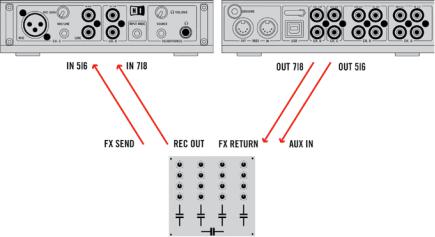
Using Send Effects
The Send Effects of TRAKTOR Scratch can process sound from the inputs of the soundcard. This allows you to route a microphone through the effects, and also to route the FX Send output of your mixer through the effects of TRAKTOR Scratch.
The following diagram shows how to connect your mixer to the AUDIO 8 DJ for using the Send Effects.
Effects Setup
Mix Mode
The Audio Preferences of TRAKTOR Scratch offer a special output called
Mix Mode. In this mode the outputs of Send Effects and Preview Player are all merged into OUT 5|6 allowing the connection to mixers that have only one single auxiliary input.
Here is how the outputs are routed within TRAKTOR Scratch.
Mix Mode ON:
• |
SFX 1 |
to |
OUT 5|6 |
• |
SFX 2 |
to |
OUT 7|8 |
• |
Preview |
to |
OUT 7|8 |
30 – TRAKTOR SCRATCH
